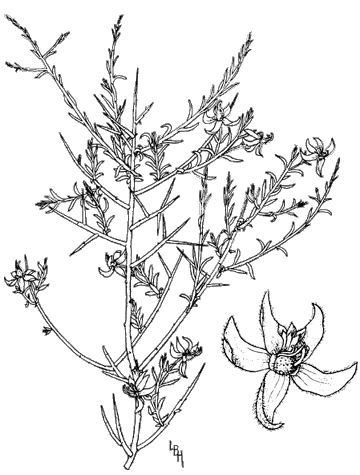Krameraceae (krameria family)
Krameria spp.
English name: ratany
Spanish names: mamelique, chacaté, cósahui, guisapol colorado,
mezquitillo (little mesquite)
 |
Description
This is a small family of 15 species. Ours are finely-branched woody shrubs to about three feet (1 m) tall and wide. The tiny leaves are less noticeable than the dense stems. Small, irregularly-shaped, deep reddish-purple flowers are borne in profusion in late spring. The two common species in our region, K. grayi and K. erecta, are extremely similar in general appearance.
Range
Warm deserts from southern Nevada to northern Mexico, California to Texas.
Notes
Ratanys are partial parasites. They have chlorophyll and photosynthesize, but their roots invade those of other plants to usurp nutrients. Nearly every fruit is infested with a tiny moth larva that eats the developing seed, and fruits with viable seeds are not common. Nothing is known about the moth’s life cycle; it may even be an unnamed species.
Ratany is among the small number of plants with flowers that produce oil instead of nectar as a food reward. Bees in the genus Centris pollinate it. Oil bees have special squeegee-like hind legs specially adapted for scraping up the oil. These bees also feed on nectar at other flowers; they provision their nests with the oil as larval food. In our region flowers of plants in the family Malpighiaceae (e.g., Janusia, Mascagnia) also produce oil.
Cósahui is sold all over Mexico as a major medicinal plant. The O’odham use the roots for a red dye in basketmaking.










